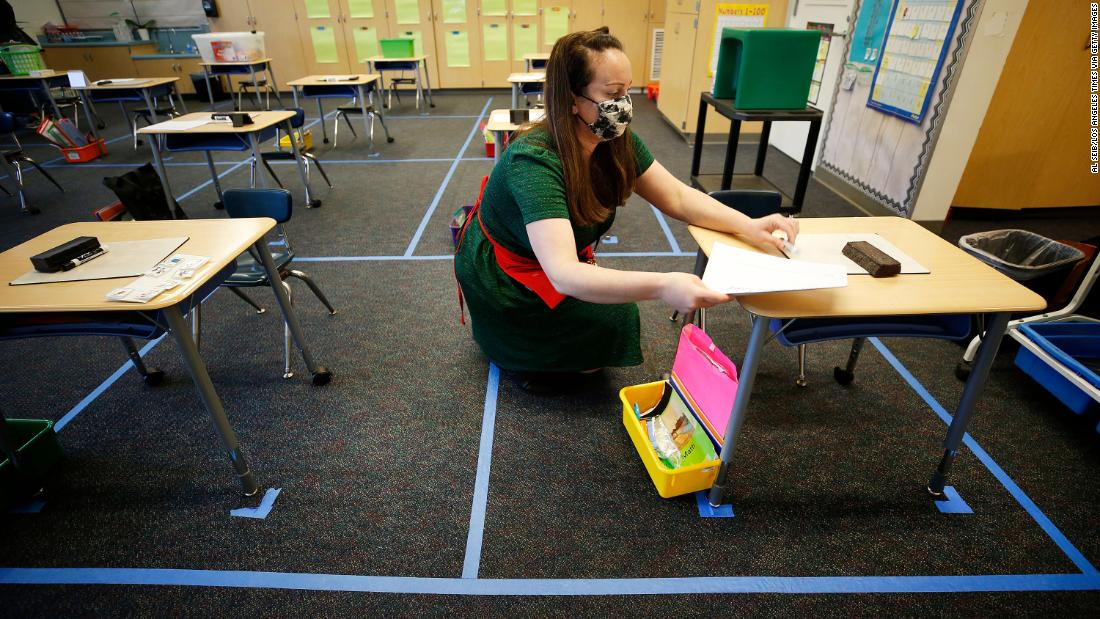The Biden government is pushing to reopen schools, an issue that some consider linked to the reopening of the economy and the return to normal life in America.
A government official told CNN that the CDC’s five main strategies for reopening schools include hand washing, masking, social detachment, cleaning and ventilation, as well as contact tracking, isolation and quarantine.
The guidance will not suggest that staff be vaccinated, instead it describes vaccination as another “stratification” strategy, since many schools were able to reopen safely before vaccines were available, the official noted.
The guidelines will also note that screening – testing people for asymptomatic cases or people who are infected but have not yet fallen ill – can improve case detection.
But some teachers and unions are resisting plans to reopen, many with demands for vaccinations and more supplies.
The National Education Association (NEA) interviewed 3,305 of its members and said on Tuesday that 82% have not yet received the Covid-19 vaccine. On Monday, at least 26 states and Washington DC said they would allow some or all of the school’s teachers and staff to receive the Covid-19 vaccine.
Some have also raised concerns about equity, noting that current access to finance and supplies needed to meet safe reopening standards is often directed towards wealthier jurisdictions.
“Most schools, especially those attended by black, brown, indigenous and poor white students, have extremely outdated ventilation systems and no noteworthy testing or screening program,” said NEA President Becky Pringle.
Pringle noted that messages from CDC and other leaders carry weight and hopes that the new orientation will be supported by funds from federal and local entities
“We need to ensure that we have the additional funds to help our most marginalized students and schools, because we are digging out of a hole here,” said Pringle. “Here we are with outdated ventilation systems – sick buildings – to which we want to send the children back with the coronavirus still strong.”
President Joe Biden’s Covid-19 relief proposal would include $ 170 billion for K-12 schools, colleges and universities that could be targeted for mitigation measures.
What does science say?
Experts say that with the right precautions, a return to face-to-face learning can be safe – even before all teachers and staff are vaccinated.
“Schools should be the last places closed and the first places open,” said CDC director Dr. Rochelle Walensky, during a meeting at the White House last week. “Our goal is to ensure that children return to school with the safety of children and teachers.”
Walensky said earlier that vaccinating teachers “is not a prerequisite for the safe reopening of schools”.
In a CDC study, mitigation measures, including social distance, contact tracking and wearing masks – provided to students through a donation from a private foundation – helped 17 rural schools in Wisconsin achieve 37% transmission rates lower than those of the wider community. Of the 191 cases of Covid-19, only 3.7% were contracted at school.
These mitigation measures can make a big difference. Another CDC study detailed how two wrestling matches in Florida high schools – a high-contact sport that does not allow masking or social detachment – became over-sprawling events that led to the loss of about 1,700 classroom days.
Previous CDC advice for schools
After Covid-19 began to establish itself in the US, the CDC offered some considerations for closing schools in March last year, noting that suspending face-to-face learning for eight weeks or more would likely have the most impact in mitigating community spread. than fewer closures in response to positive cases. Some schools have switched to virtual learning for the remainder of the school year.
Before the new school year in August, the CDC advised communities to weigh the benefits of face-to-face learning against the risks of reopening schools in the midst of a pandemic. The agency advised jurisdictions to make decisions about face-to-face learning based on their level of diffusion in the community.
For schools that allow face-to-face learning, the CDC emphasizes the importance of maintaining a clean environment, wearing masks and social distance. Schools were instructed to try to keep students and teachers in separate groups throughout the day and to have lunch outside when possible.
Experts warn that learning during a pandemic can be difficult for students. The agency advised schools to maintain mental health services and offer remote counseling.
In the following months, schools adopted varied approaches that include face-to-face learning, online learning and a combination of the two.
Keeping track of transmission rates – and perhaps the presence of variants of the virus – will help people control anxiety and make informed plans about reopening schools, said Dr. Stuart Ray, professor of infectious disease medicine at the University Johns Hopkins. Dashboards and other tools to assist with data collection can help jurisdictions stay informed.
Tests will also be a valuable tool, Ray noted. “It makes a big difference to do some tests and not just symptom-based screening, particularly when children are less likely to be symptomatic than adults,” he said.
As for teachers and school staff, Ray said there is no doubt that there is some level of risk involved in returning to personal learning before everyone is vaccinated, but tools like personal protective equipment can help make everyone safer.
“We need some guidance on how to factor in an effective PPE so that people who have not been vaccinated can still be safe – as we demonstrated that healthcare professionals could be in 2020, before a vaccine is available,” he said.
One of the most effective ways for people to help make teachers, staff and students safer within schools is by helping to control the spread of the virus outside schools, Ray said.
“If people are really careful about masking and distancing themselves out of schools, schools will become safer,” he said.
CNN’s Ben Tinker, Jen Christensen, Jacqueline Howard and Meridith Edwards contributed to this report.
